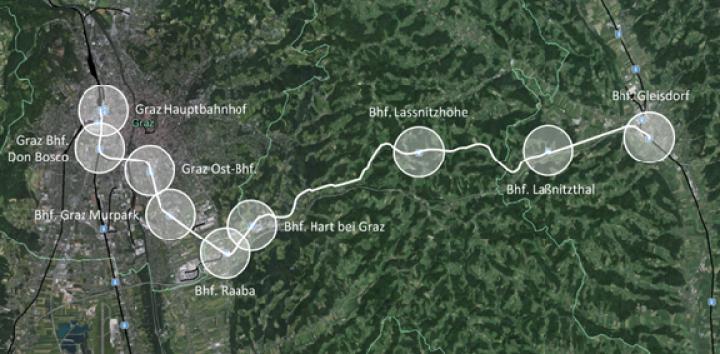G2G – Innovation axis Graz-Gleisdorf
Short Description
Starting point/Motivation
The forecasted dynamic population and economic growth in the urban agglomeration around Graz (490,000 inhabitants by 2050) poses major challenges in terms of resource consumption, waste management, mobility and affordable housing. In addition to growing inner-city densification, development areas and regional centers beyond the core of the city have to be included into the planning process. The suburban railway network of Styria, which connects Graz with surrounding municipalities and cities, has an immense future potential that must be leveraged in a targeted manner.
Contents and Objectives
The goal of the project was to develop two testbed and demonstration zones along the Graz-Gleisdorf innovation axis. These zones are located within already designated areas for urban development and in the proximity of the suburban railway junctions. It is expected to develop an innovation and technology portfolio with a focus on energy, integrated building technology, smart urban spaces, compact settlement structures, generational living, cities of short distances, intermodal mobility as well as ICT-based solutions, which will provide basis for implementation within the demonstration areas (time frame for the portfolio is 2019/2020). The Graz-Gleisdorf innovation axis is thus intended to make a significant contribution in terms of development of resilient urban agglomerations with high resource and energy efficiency, increased use of renewable energy sources and high quality of life.
Methods
In accordance with the principles of "transit oriented development", the potential of selected development areas along the suburban railway axis Graz-Gleisdorf was analysed using an interdisciplinary approach. The development of the innovation and technology portfolios is based on an extensive literature and project research as well as evidence gathered during workshops and expert discussions, following an open and cooperative innovation process and involving all relevant stakeholders.
The Sustainable Process Index (SPI®) has been used in order to illustrate the contribution of the portfolio on reducing environmental footprint. SPI is an "ecological footprint" assessment tool and is in line with international standards for life-cycle analysis.
Results and prospects
The major outcome of the project is a comprehensive implementation concept for the innovation and technology portfolios along the two selected suburban railway junctions (Murpark Graz and Bahnhof Gleisdorf).
During the one-year project period, however, it has been shown that no binding decisions can be taken to implement measures by 2019/2020. This is due to different planning horizons of the affected actors in both demonstration areas. Moreover, the cooperation between those actors can be still considered low. As a result, projects (for example, construction of residential areas) are usually developed without any explicit reference to the potential of suburban railway junctions. In that sense, an enhanced cooperation would be necessary in order to initiate more efficient and effective innovation processes and to implement innovative measures.
All in all, it was possible to increase the awareness of joint, coordinated approaches for project development and to establish a stronger stakeholder network necessary for the implementation of the technology and innovation portfolio in the foreseeable future. To this end, it will be necessary to carry out further supporting processes. These could be for instance achieved within the framework of the Styrian mobility innovation lab "Graz grenzenlos" which will start its activities in autumn 2017.
Project Partners
Project management
Mag. Barbara Hammerl, StadtLABOR Graz
Project or cooperation partners
- AEE INTEC Gleisdorf
- Technische Universität Graz
- PLANUM Fallast, Tischler & Partner GmbH
Contact Address
StadtLABOR Graz
Barbara Hammerl
Reininghausstraße 11a
A-8020 Graz
Tel.: +43 (316) 22 89 46
E-mail: barbara.hammerl@stadtlaborgraz.at
Web: www.stadtlaborgraz.at

